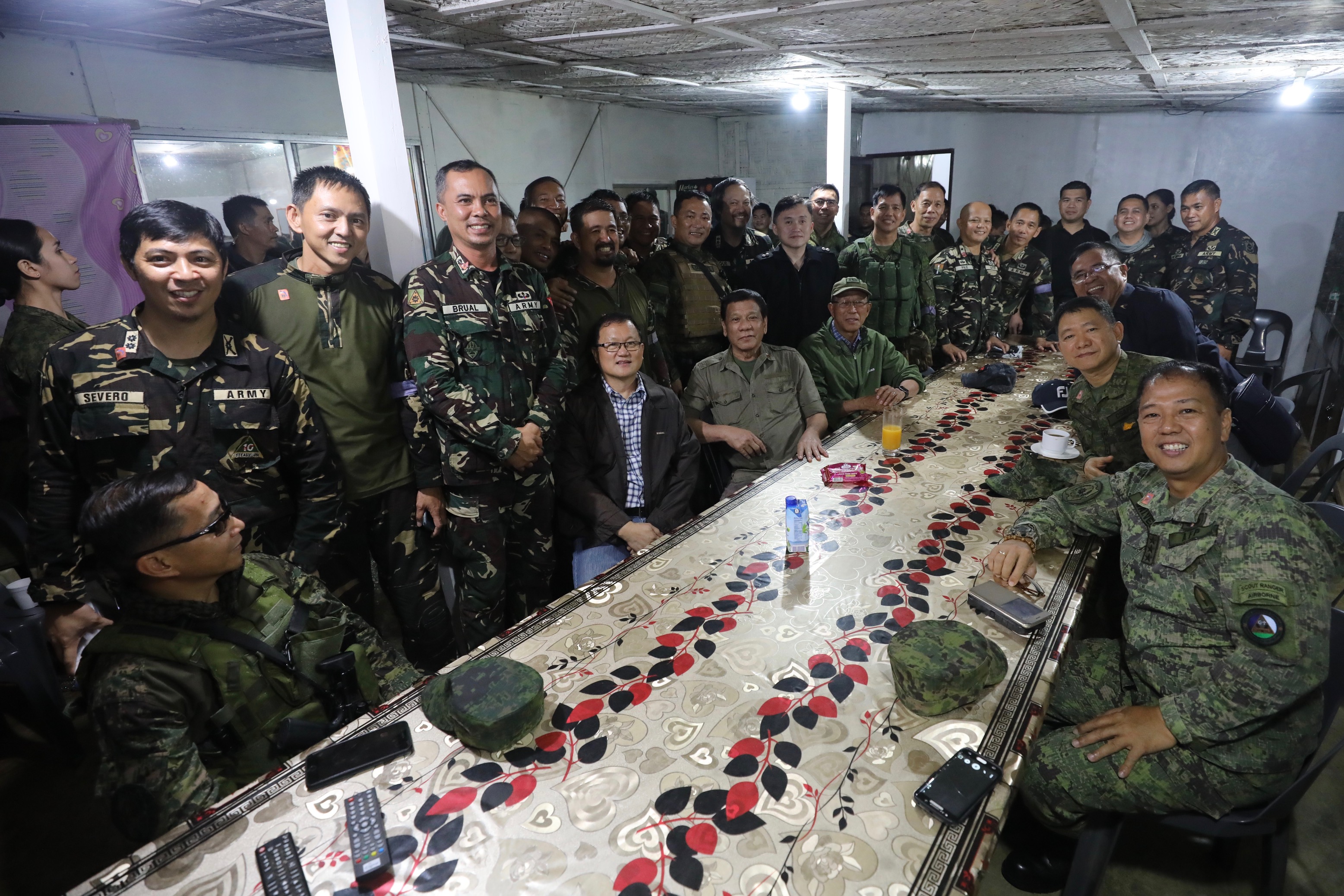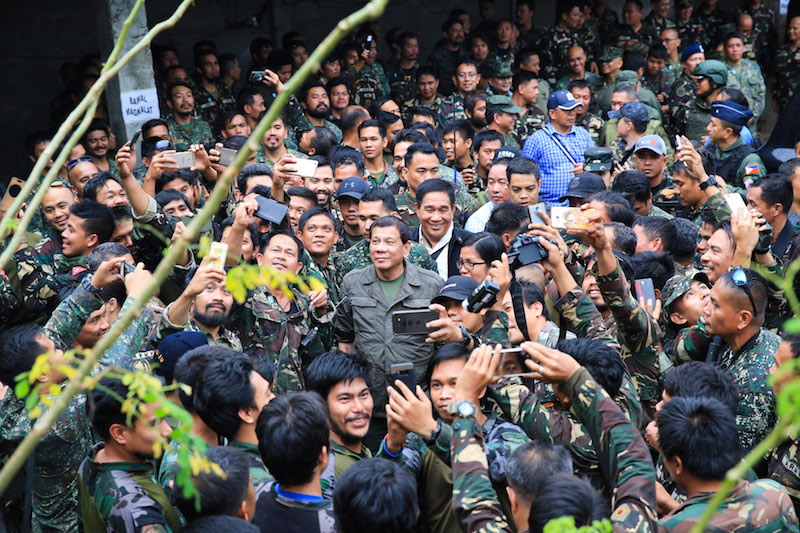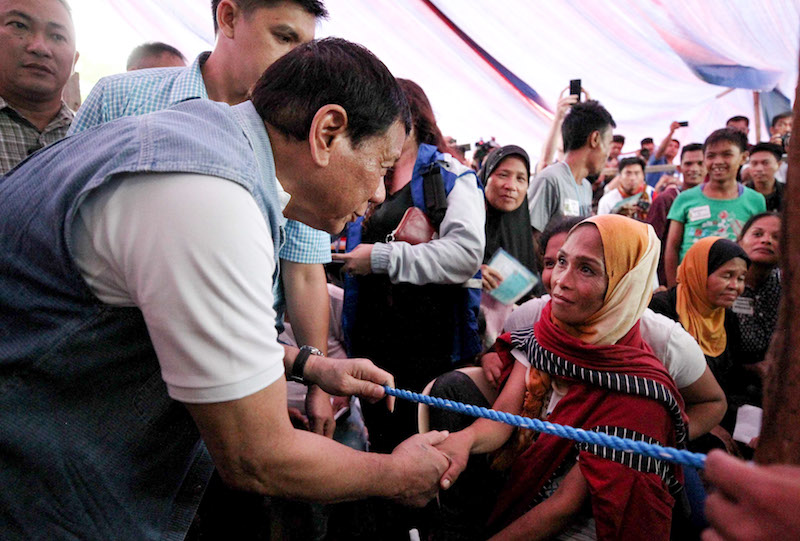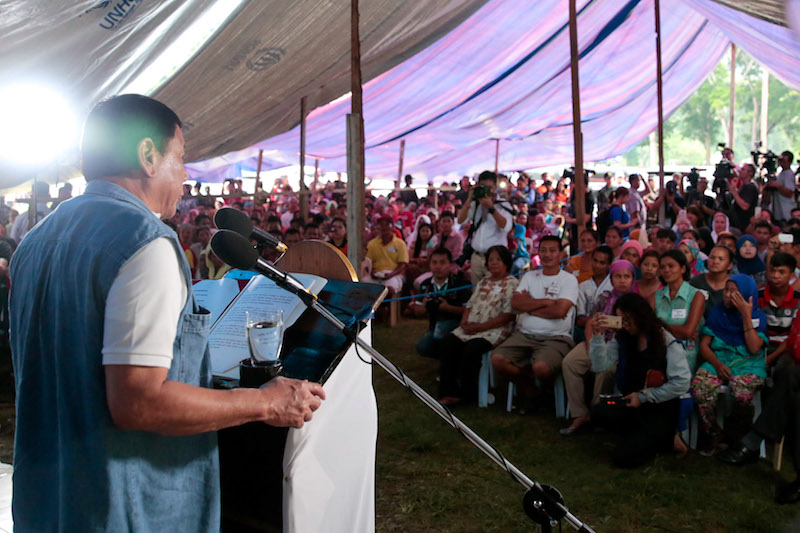MindaNews (22 Sept) — Two days after he said he will be “going to Marawi any day soon,” President Rodrigo Duterte did on Thursday, September 21, Day 122 of the Marawi Crisis, his fifth visit to his troops which came 10 days after his fourth.
 President Rodrigo Duterte on his fifth visit in Marawi City last Sept. 21, 2017. PRESIDENTIAL PHOTO
President Rodrigo Duterte on his fifth visit in Marawi City last Sept. 21, 2017. PRESIDENTIAL PHOTO
Duterte, whose Presidential campaign slogans included “TAMA si Duterte” (Duterte is right; also taken from TApang at MAlasakit or Courage and Compassion), did show his courage in visiting the troops at the frontlines on July 20, August 4, August 24, September 11 and September 20.
But he has been found wanting in showing compassion to the victims of war — the displaced residents of Marawi — whom he visited only once, on June 20, at the evacuation center at the National School of Fisheries in Barangay Buru-un in Iligan City where 174 families had sought refuge.
Duterte asked forgiveness for the devastation of Marawi City, the deaths and mass displacement of its residents, explaining he had no choice but to drive the terrorists out of the country’s lone Islamic City.
He asked them not to worry. “Huwag kayong mag-alala. Tutulungan ko kayo. Hindi ko kayo pababayaan, hanggang relocation” (Do not worry. I will help you. I will take care of you until relocation).
It was Day 29 when he visited. At that time, several “in two to three days it will be over,” “the end is near,” “we’re winding up,” deadlines had been announced by Duterte, the Defense Secretay and senior military officials and had lapsed but the clashes and air strikes against the Maute had continued.
“Winding up”
Duterte in a media interview after visiting the wounded at the Camp Evangelista Station Hospital in Cagayan de Oro City on the the same Day 29 said: “they (soldiers) are winding up in Marawi except for a few snipers left behind. But I do not think that it would last a little longer than expected.”
Three months and one day later, in Marawi on September 21, Day 122 of the Marawi Crisis, Duterte told a press conference at the 103rd Brigade’s Camp Ranao, that the soldiers were “winding up.”
 Return to Marawi
Return to Marawi
President Rodrigo Duterte returned to Marawi City on Friday, 04 August 2017, exactly 15 days since his first visit in the 103rd Infantry Brigade’s Camp Ranao. Friday’s visit was at the Tactical Command Post of the Joint Special Operations Task Force Trident in Barangay Kilala, Marawi City. The President brought along groceries and watches for the troops. Albert Alcain / PRESIDENTIAL PHOTOS
“The Armed Forces is winding up but there are still the hold-outs and the hostages,” Duterte said, adding what he had earlier repeatedly said, that what has delayed them is “as much as possible, we do not want anybody taken hostage by the terrorist, harmed or killed.”
“Magwa-winding up na ito. And sabi ko nga sa mga sundalo, ‘We will not have any celebration. After all has been said and done, we will just go out quietly.’ Pack their things and go home,” Duterte said, but added he would “insist on a thanksgiving mass.”
“But only for those living. For the — especially for those who are brother soldiers who died along the way,” said Duterte who did not finish this sentence. He must have meant a thanksgiving mass for the living and a requiem mass for those who perished in the four-month war.
But he maintained there will be no celebration because “walang nanalo dito eh” (nobody won here).
Three days to four months
Marawi residents fled the war zone thinking their stay in the evacuation centers or with relatives’ houses would be temporary — about three to four days.
The days turned to weeks, the weeks into months. The predominantly Muslim ‘bakwits’ had in fact observed Ramadan, Eid’l Fitr, Eid’l Adha and Amun Jadid as of September 21 as ‘bakwits.’
As a result of the diaspora, thousands of residents have been scattered nationwide — most of them in neighboring cities like Iligan and Cagayan de Oro, a number in other areas in Mindanao, the Visayas and even faraway Luzon.
The Department of Social Welfare and Development (DSWD) has recorded 78,466 families or 359,680 persons have been displaced by the armed conflict in Marawi and neighboring towns based on the Disaster Assistance Family Access Cards (DAFAC) as of September 2.
Most of the ‘bakwits’ are home-based but there are still 73 evacuation centers currently open in 17 municipalities in Lanao del Norte and Lanao del Sur.
 President Rodrigo Roa Duterte interacts with some of the evacuees from Marawi City during his visit at the Iligan City National School of Fisheries on June 20, 2017 where 229 displaced families have taken shelter. Ace Morandante / PRESIDENTIAL PHOTO
President Rodrigo Roa Duterte interacts with some of the evacuees from Marawi City during his visit at the Iligan City National School of Fisheries on June 20, 2017 where 229 displaced families have taken shelter. Ace Morandante / PRESIDENTIAL PHOTO
Also on June 20, Duterte vowed to rehabilitate Marawi, initially promising 20 billion pesos but three more months of daily air strikes and bombardments later, even Defense Secretary Delfin Lorenzana, who chairs the rehabilitation coordinating body, Bangon Marawi, has acknowledged that even 50 billion pesos would not be enough to rebuild Marawi.
Duterte assured Marawi would rise from the ruins. “Gaganda ‘yan uit, gaganda ulit ‘yan” (That will be beautiful again. It will be beautiful again,” he said on June 20.
On September 21 he told reporters in Marawi: “We will need a lot of money to rebuild Marawi. I have promised that to the people of Marawi. And I will comply and abide by my promise.”
Duterte said he has “money to start rehab” of Marawi.
“I cannot build them mansions, but I can build decent houses for them. I cannot provide the destroyed mansions there. We do not spend for the rich people. We only spend for those less fortunate and do not… cannot afford,” the President said.
“I am very, very, very sorry”
In his June 20 visit to the ‘bakwits’ in Iligan City, the President gave a thousand pesos assistance for each family which then Social Welfare Secretary Judy Taguiwalo said is part of the P5,000 cash assistance per evacuee family, the remaining P4,000 of which would be given only upon return to Marawi.
In the same visit, Duterte, whose grandmother was a Maranao, apologized to and asked forgiveness from the Maranaos.
“I would like to say to the Maranao people that I am very, very, very sorry na nangyari ito sa atin. Sana kung madaling panahon (that this happened to you. Hopefully soon) you will find a new heart to forgive my soldiers, ang gobyerno, pati ako for declaring martial law. Wala akong choice eh sinisira na ang Marawi.”
The country’ first President from Mindanao told Maranaos he hopes they “will find a new heart to forgive my soldiers, ang gobyerno, pati ako for declaring martial law.”
 President Rodrigo Duterte apologizes to Maranaos for the devastation, deaths and mass displacement but explained he was left with no choice. Duterte visited an evacuation center at the Iligan City National School of Fisheries on June 20, 2017, where 229 displaced families families have taken shelter. Rey Baniquet / PRESIDENTIAL PHOTO
President Rodrigo Duterte apologizes to Maranaos for the devastation, deaths and mass displacement but explained he was left with no choice. Duterte visited an evacuation center at the Iligan City National School of Fisheries on June 20, 2017, where 229 displaced families families have taken shelter. Rey Baniquet / PRESIDENTIAL PHOTO
“But I am very sorry. Paki-abot na lang doon sa mga kapatid nating mga Maranao na ang aking paghihinanakit rin sa nangyari na ito. (Please extend to our fellow Maranaos that I am hurt that this happened). Patawarin ninyo po kami” (Please forgive us), said the President who earlier in his speech admitted he “felt betrayed” by the Maranaos.
“I felt betrayed. Talagang nasaktan ako” (I was really hurt), he said, claiming the people of Lanao del Sur did not bother to report to authorities that the Maute Group had been building up its forces and firepower in the city.
“Masama ang loob ko, kasi hindi naman ninyo sinabi na malakas na ang pasok (ng Maute” (I feel bad because you did not say that the terrorists have been gaining foothold in the city), he added.
Maranao leaders have also expressed their hurt over the decision of the Duterte administration to launch military operations, impose martial law and conduct air strikes and not give another chance for the traditional settlement of conflicts.
Within the four-month war, negotiations done the traditional way, through emissaries, saved 134 lives on June 4 during the four-hour “humanitarian pause” to allow trapped residents to leave the conflict zone. The “humanitarian pause” was conducted through the Peace Corridor launched by the government and Moro Islamic Liberation Front and five others on June 25, during the eight-hour humanitarian ceasefire that was later extended to another two hours as declared by government and reciprocated to by the Maute Group on Eid’l Fitr, the end of the month-long Ramadan. (Carolyn O. Arguillas / MindaNews)
